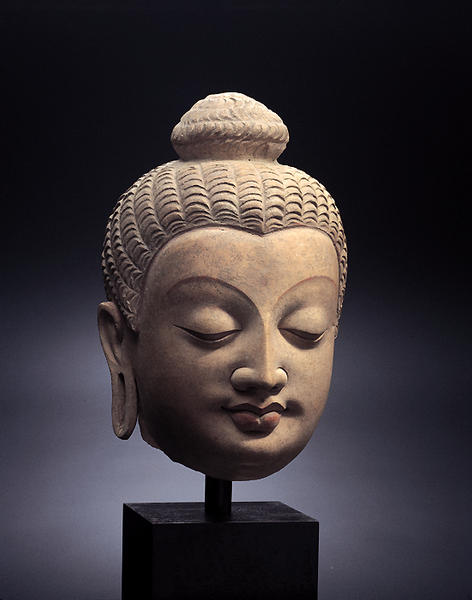仏頭
- ハッダ/タキシラ
- 4-5世紀
- ストゥッコに彩色
- H-26.5 W-17.6
この仏頭はおそらく等身大以上の像だったと思われる。彩色されたあとと、全体に朱線が残っていが、唇の朱彩は非常に鮮やかなので、当時のものではないであろう。形式的な頭髪から考えると、この像は型を用いて作られたものであろう。右耳は別に作って接着し、左耳は失われた痕が残っている。ハッダやタキシラのストウッコ彫刻は、固定した木材に縄を巻いたものを芯にして、植物繊維を混ぜた粘土を盛り上げて全体の形を作り、きめの細かい土で表面を整えていく。さらに面部は上質の白土で仕上げて彩色を施した。粘土を盛り上げるため、目、鼻、口などの細部を簡単に成形出来、柔らかい素材の肌合いが肉体や布の質感を表すのに適していた。顔や腕や胴といった部分毎に型を用いる事も多く、変化に富むポーズの像を大量生産する事が出来た。この製法は中国や日本の塑造彫刻と基本的に一致している。
Catalogue Entry
This large head of a Buddha image is thought to have originally been part of an over-life-size sculpture. There are traces of polychrome, with cinnabar on the ushnisha (cranial protuberance), the eyebrows, the outlines of the eye sockets and the wings of the nose, the edges of the eyelids, the groove beneath the nose, and the earlobes. The cinnabar red on the lips is extremely fresh and not original. The formalized portrayal of the hair indicates that this image was created from a mold. The right ear seems to have been made separately and attached; only traces of the left ear remain. In addition to the smooth bridge of the nose, the intellectual facial features, and the sharp curve of the eyelids of the half-closed eyes, the strong tightening of the swell of the lower lip at the base of the mouth and the fleshy cheeks are related to the sensual Gupta style.
In Hadda and Taxila a stucco sculpture was made by first winding rope around a wood armature affixed to a wall and then modeling the general form of the figure by building up clay mixed with vegetable fiber around the rope core. Extremely fine clay was then used to finish the surface, and a particularly high grade of white clay was used for the face, which was then decorated with polychrome. The thin elements, such as fingers, were formed around cloth-wrapped wires. The eyes, nose, mouth, and details of the clothing were modeled by scraping with a spatula. The use of clay enabled repairs to be made more easily than on stone sculptures, and the texture of the soft material was especially suited for expressing of the qualities of flesh and drapery. Frequently faces, chests, and torsos were molded separately, a technique that allowed for the mass production of figures in a rich variety of poses. This production method was fundamentally the same as that used in China and Japan. TK
